Data Brief 2021-014 | May 21, 2021 | Written and compiled by Leila Gonzales and Christopher Keane, AGI
Download Data Brief
COVID-19 Impacts to Academic Department Operations, April 2021
This data brief provides an update on the state of geoscience academic
departments during the COVID-19 pandemic, including budgets, staffing,
changes to degree requirements and promotion and tenure guidelines, and
planning for the next academic term.
Budget Changes
Most departments (58%) experienced budget cuts during the 2020-2021
academic year, with 48% of departments reporting cuts of 20% or less. In
addition, 5% of departments reported increases to their budgets over the
academic year, and 38% of departments reported no change in their
budgets.
Staffing
Most impacts to departmental staffing such as salary and benefits
reductions, staff and faculty furloughs and layoffs occurred by the end
of May 2020 and continued through the summer months of 2020. From
September 2020 through January 2021, the percentage of departments
reporting no impacts to staffing remained near 90%. Starting in February
2021, impacts related to hiring freezes and leaving open positions
unfilled have started to increase, and the percentage of departments
reporting no staffing impacts declined to 68% by April 2021. In April,
12% of departments reported not being able to hire new staff. Other
impacts reported by departments since February include reduced hours for
faculty and staff, termination of summer contracts, and benefits
reductions.
The percentage of departments reporting faculty on travel or in the
field in limited locations has varied between approximately 40% and 50%
between May 2020 and January 2021.
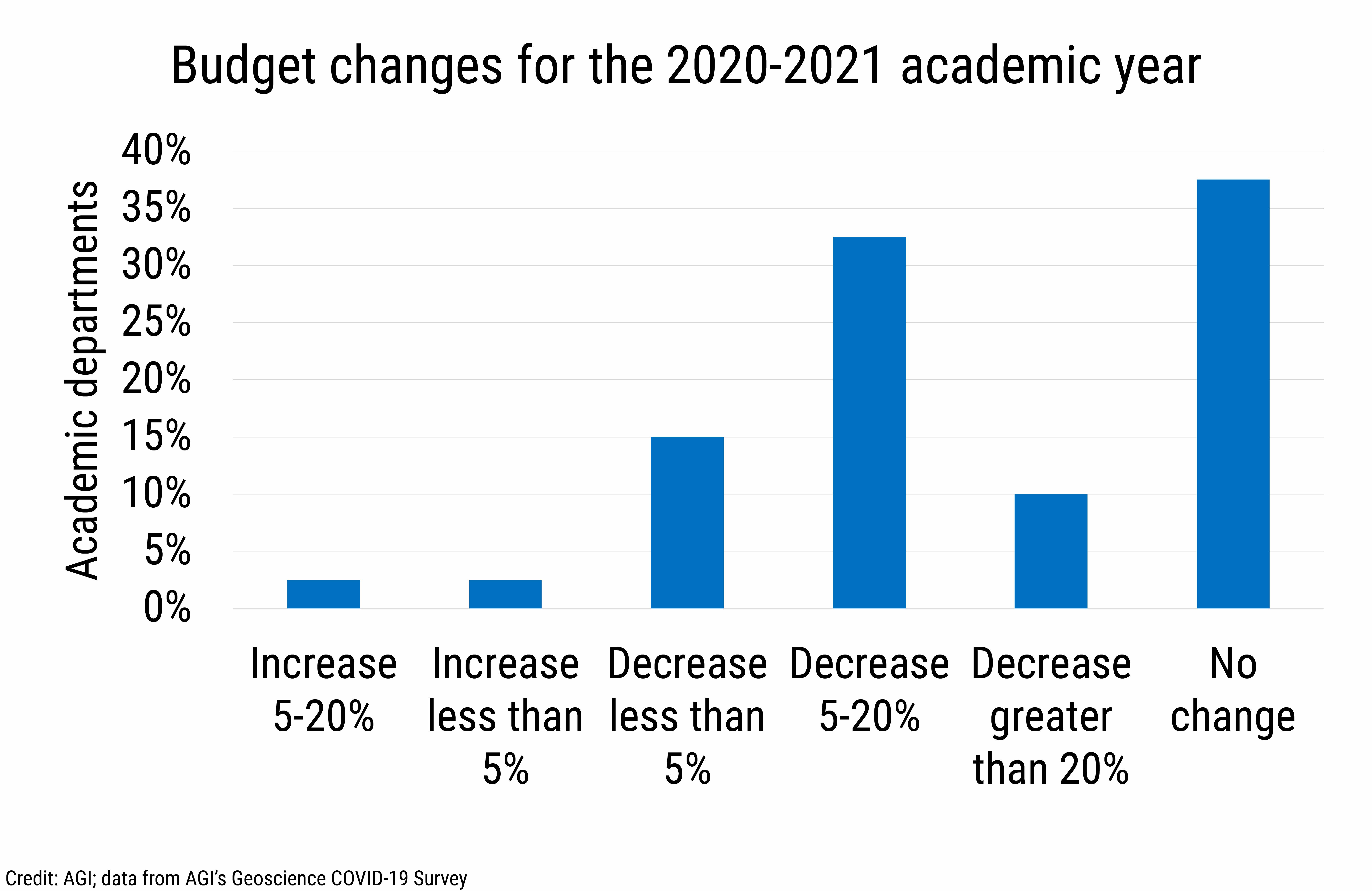
DB_2021-014 chart 01: Budget changes for the 2020-2021 academic year (Credit: AGI; data from AGI's Geoscience COVID-19 Survey)
AGI
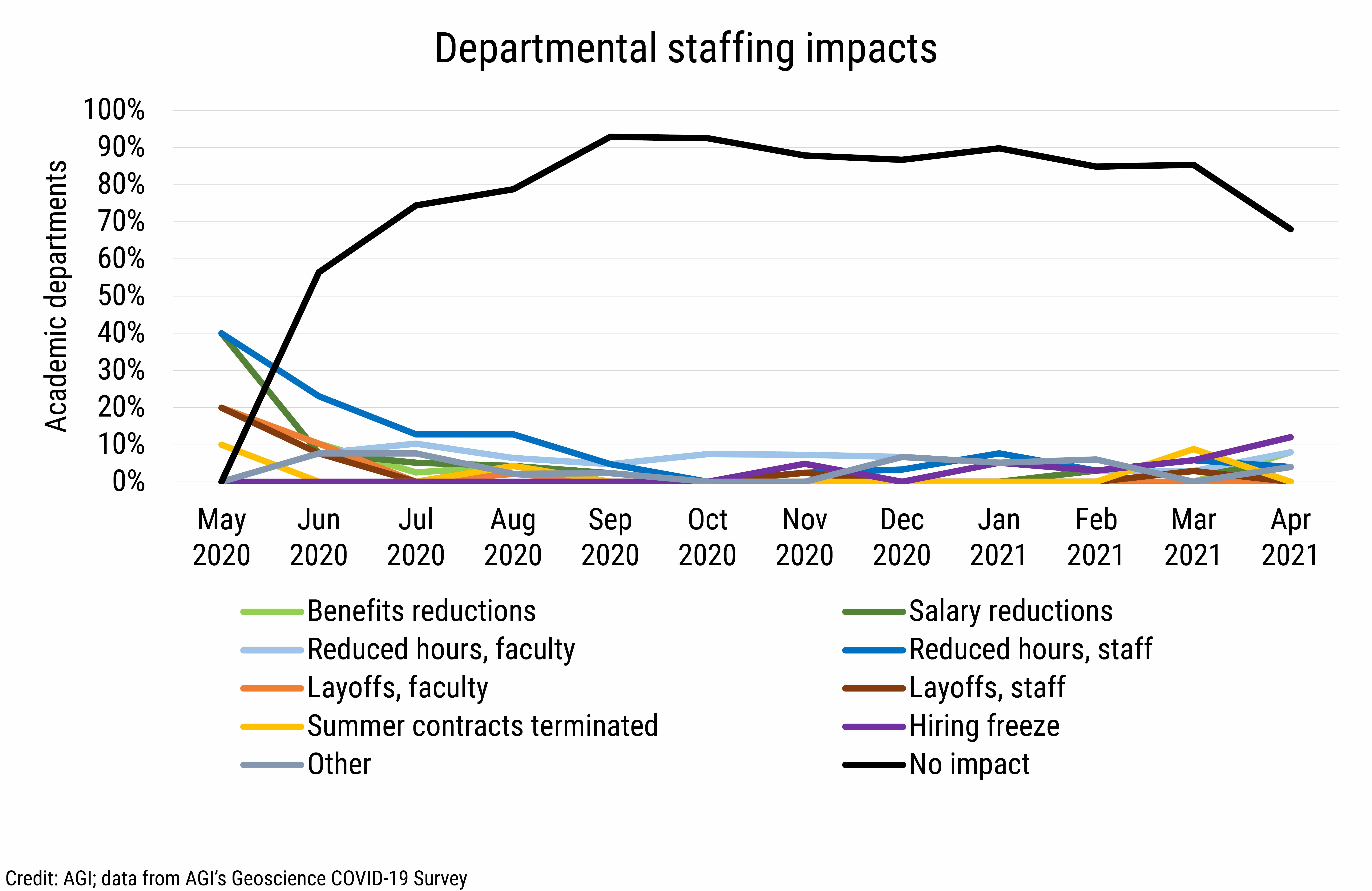
DB_2021-014 chart 02: Departmental staffing impacts (Credit: AGI; data from AGI's Geoscience COVID-19 Survey)
AGI
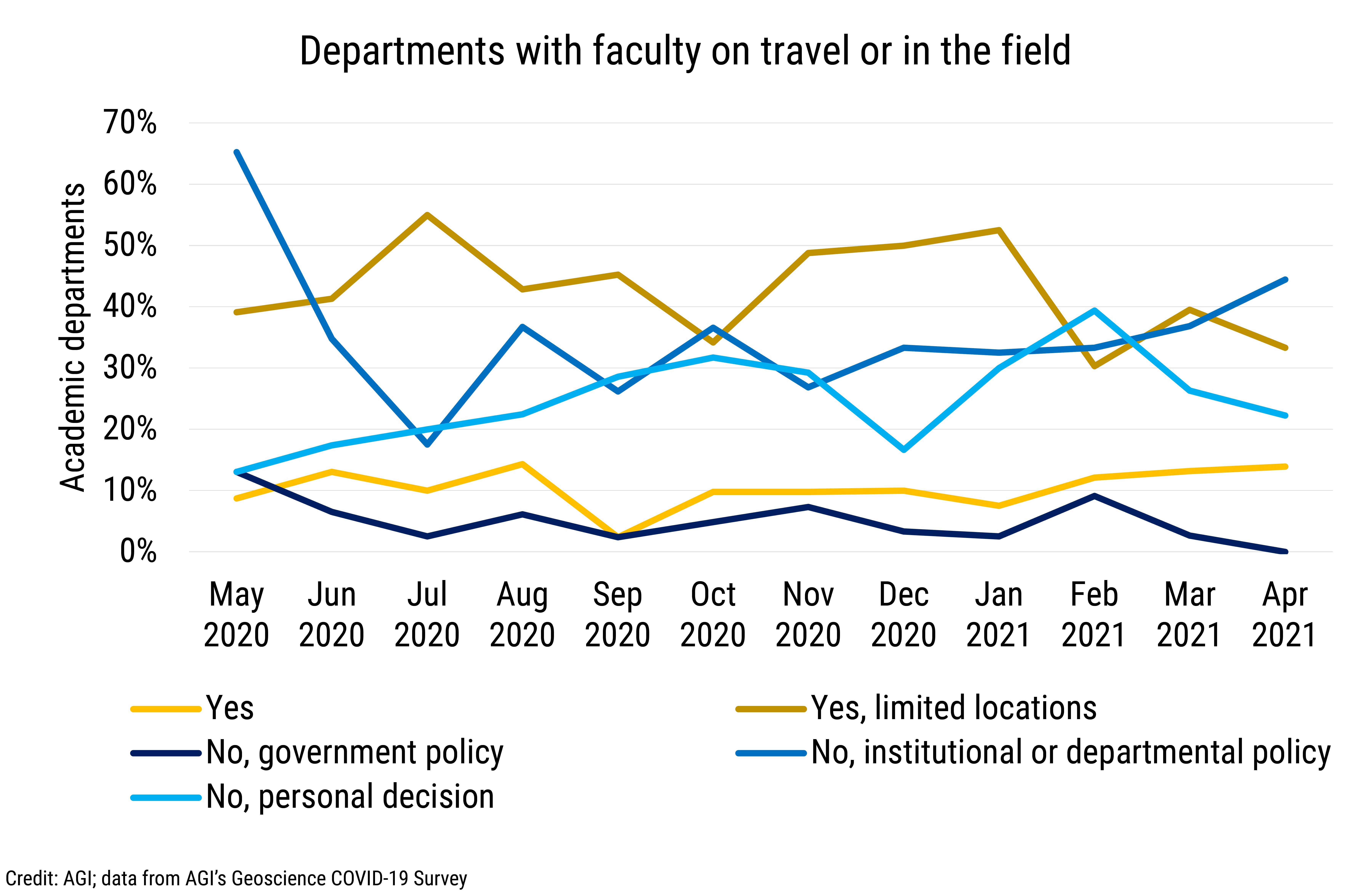
DB_2021-014 chart 03: Departments with faculty on travel or in the field (Credit: AGI; data from AGI's Geoscience COVID-19 Survey)
AGI
Since February 2021, more departments have reported institutional or
departmental policies preventing faculty travel and fieldwork, from 33%
of departments in February 2021 to 44% in April 2021. Over the same
period, the percentage of departments reporting faculty on travel or in
the field in limited locations declined to between 30% and 40%.
In April 2021, we asked departments about the workplace policies
available to faculty and staff. Over half of departments offer office,
work-from-home, fieldwork, and lab access to their faculty and staff.
While 89% of faculty reported working from home, 61% reported working
from the office or on campus. Furthermore, 84% of faculty working from
home reported working in that location at least half-time, and just over
half of faculty who worked in the office reported working in that
location at least half-time.
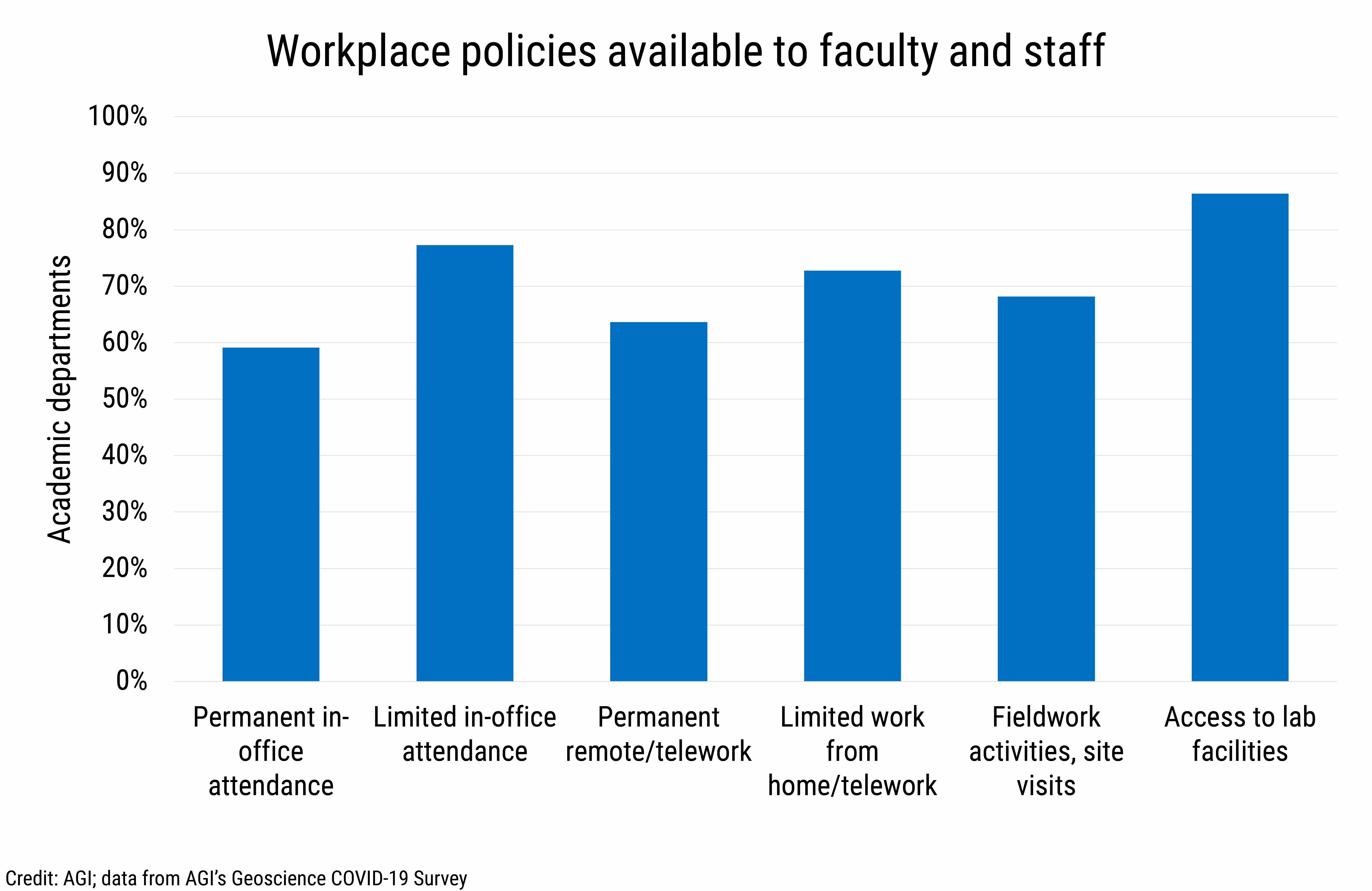
DB_2021-014 chart 04: Workplace policies available to faculty and staff (Credit: AGI; data from AGI's Geoscience COVID-19 Survey)
AGI
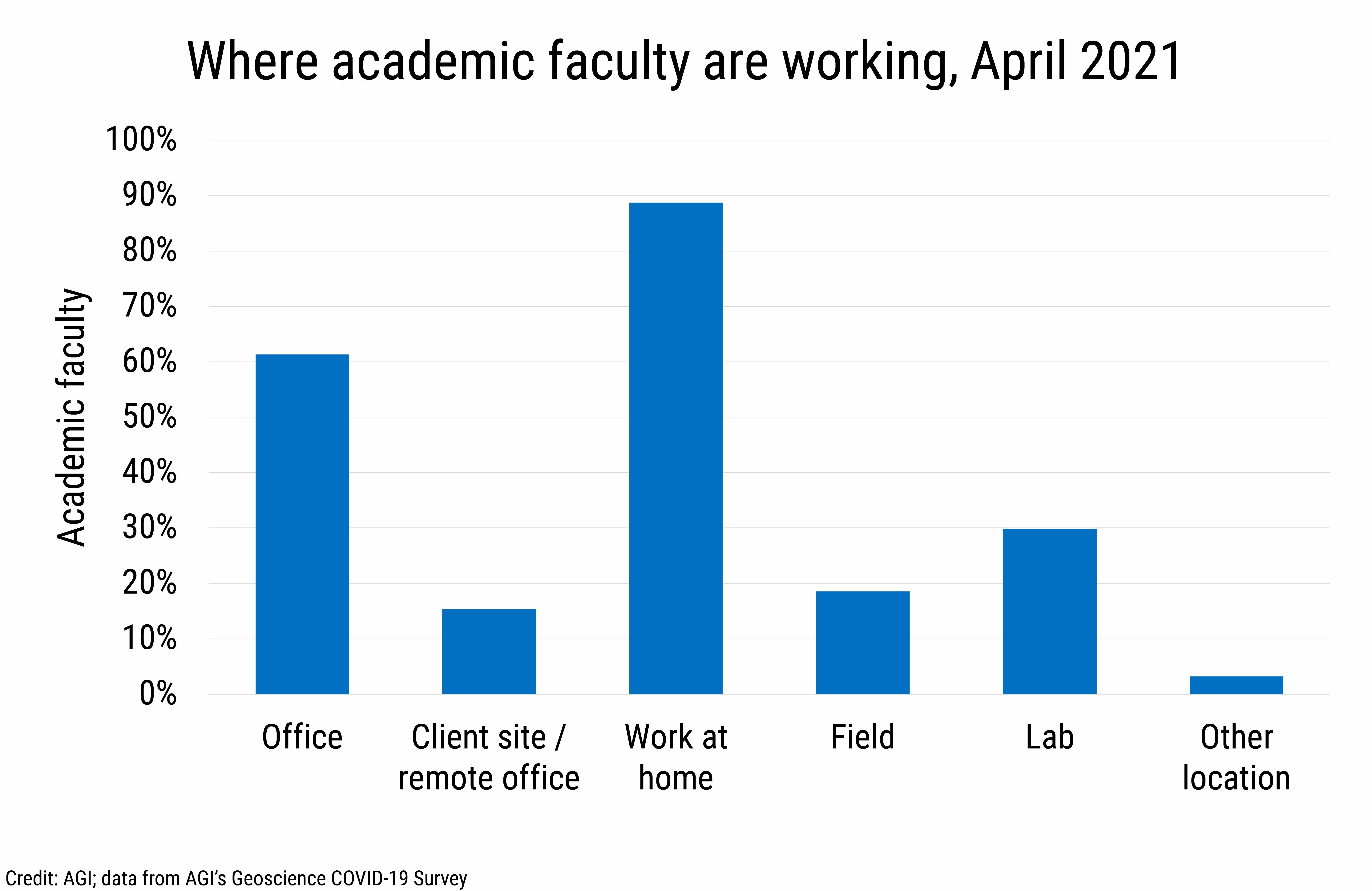
DB_2021-014 chart 05: Where academic faculty are working, April 2021 (Credit: AGI; data from AGI's Geoscience COVID-19 Survey)
AGI
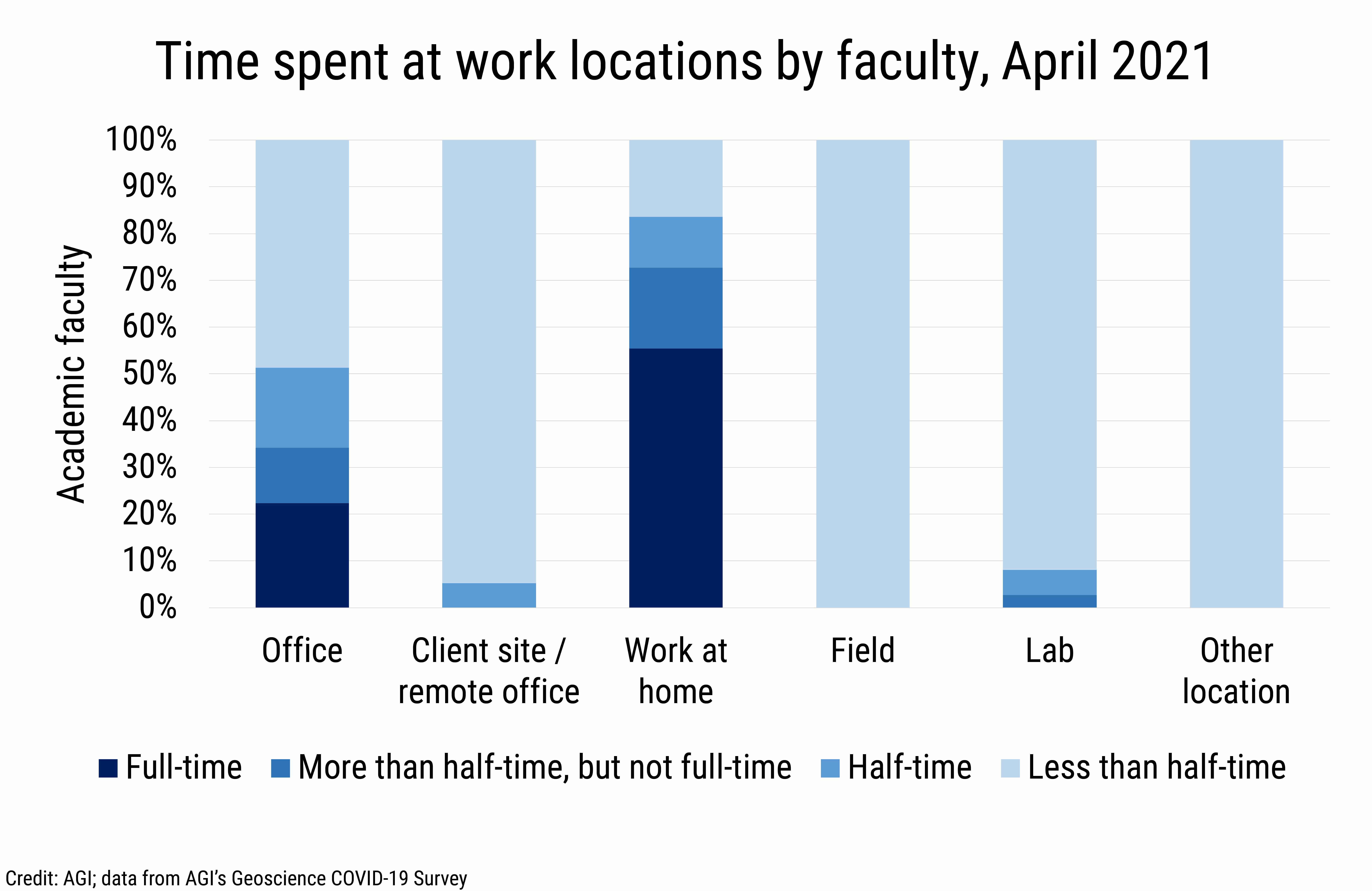
DB_2021-014 chart 06: Time spent at work locations by faculty, April 2021 (Credit: AGI; data from AGI's Geoscience COVID-19 Survey)
AGI
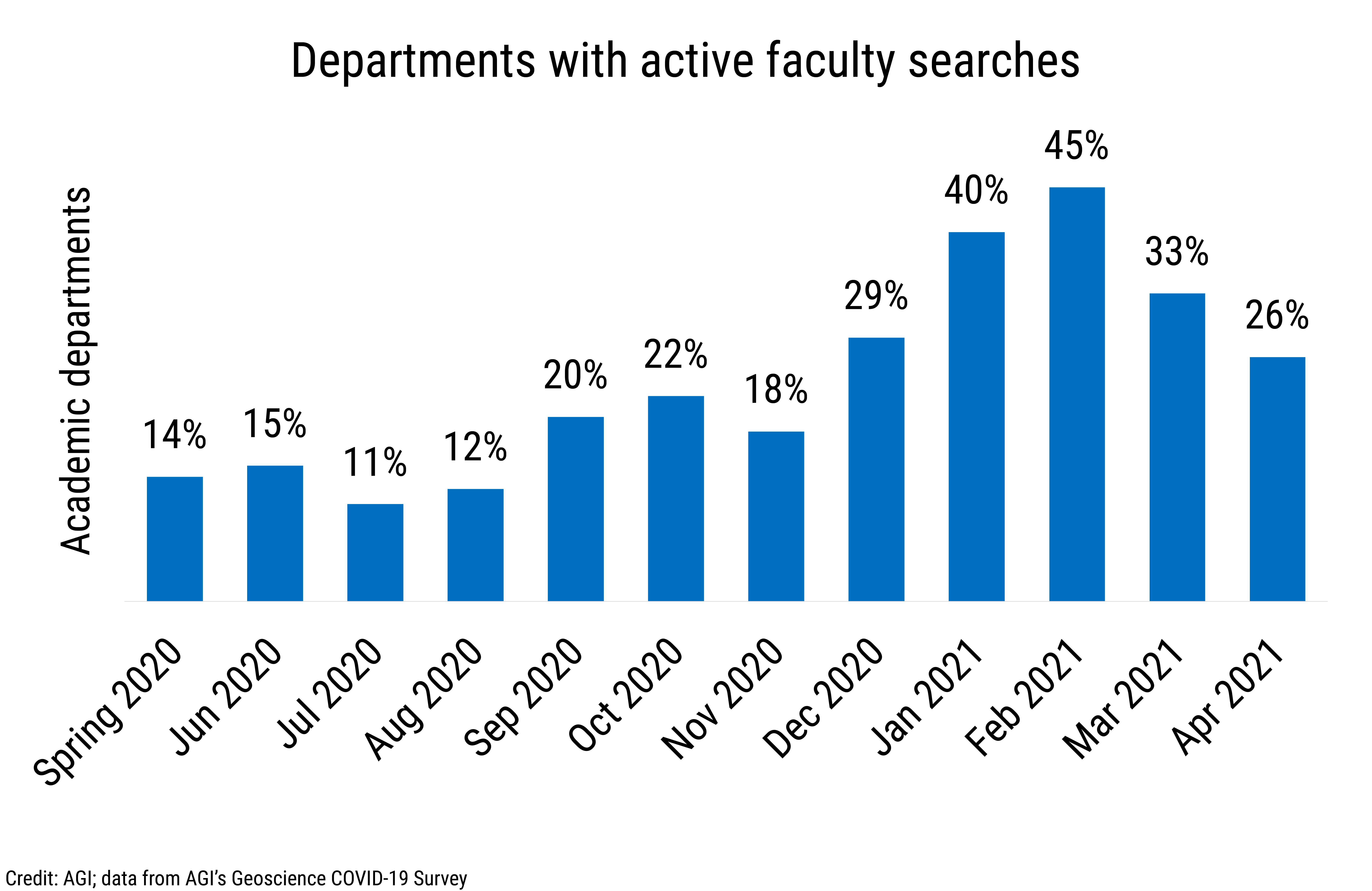
DB_2021-014 chart 07: Departments with active faculty searches (Credit: AGI; data from AGI's Geoscience COVID-19 Survey)
AGI
The percentage of departments with active faculty searches peaked in
February 2021 at 45%, and since declined to 26% by April 2021. We will
continue to track active faculty searches to understand if this is a
normal trend in faculty searches or is due to other factors.
Responses from departments and faculty were pooled as departmental
reports to understand the changes that have been made to promotion and
tenure guidelines to address the impacts from the pandemic on faculty
productivity. Sixty-three percent of departments changed their
promotion and tenure guidelines, with the most common change being an
extension of the promotion clock by one year (51% of departments).
Other tenure and promotion changes included not considering student
evaluations during the pandemic period, allowing faculty to submit
pandemic impact statements as part of their promotion review,
de-weighting performance during the pandemic, and adapting teaching
evaluation questions to be more qualitative and open-ended.
Of the faculty who reported that their departments changed the promotion
and tenure guidelines, 13% opted to take advantage of the changes, which
included taking advantage of promotion clock extensions, including
pandemic impact statements, and excluding teaching evaluations from the
pandemic period.
Changes for graduating students
As of March 2021, 72% of departments reported no change to degree
requirements for geoscience majors, while 28% did report changes.
Changes reported by departments included counting pass-fail courses
towards the major, waiving the field course requirement for students who
could not complete field courses prior to graduation this academic
year, substituting classes for required classes that could not be taken,
and accepting virtual field camps or other substitutions such as
extensive field work for the field course requirement.
In terms of final presentations for graduating students, over 90% of
departments reported that final presentations for graduating students
would be live online presentations. Just over one-quarter of departments
offered multiple formats for final presentations, usually a combination
of in-person, online, and hybrid formats.
Changes to instructional activities
Most departments reported no cancellations of lecture or lab courses or
sections for the 2020-2021 academic year. Although half of departments
reported no cancellation of field components to courses and 45% of
departments reported no cancellation of field courses, field activities
were more likely to be cancelled due to the pandemic than other
instructional activities.
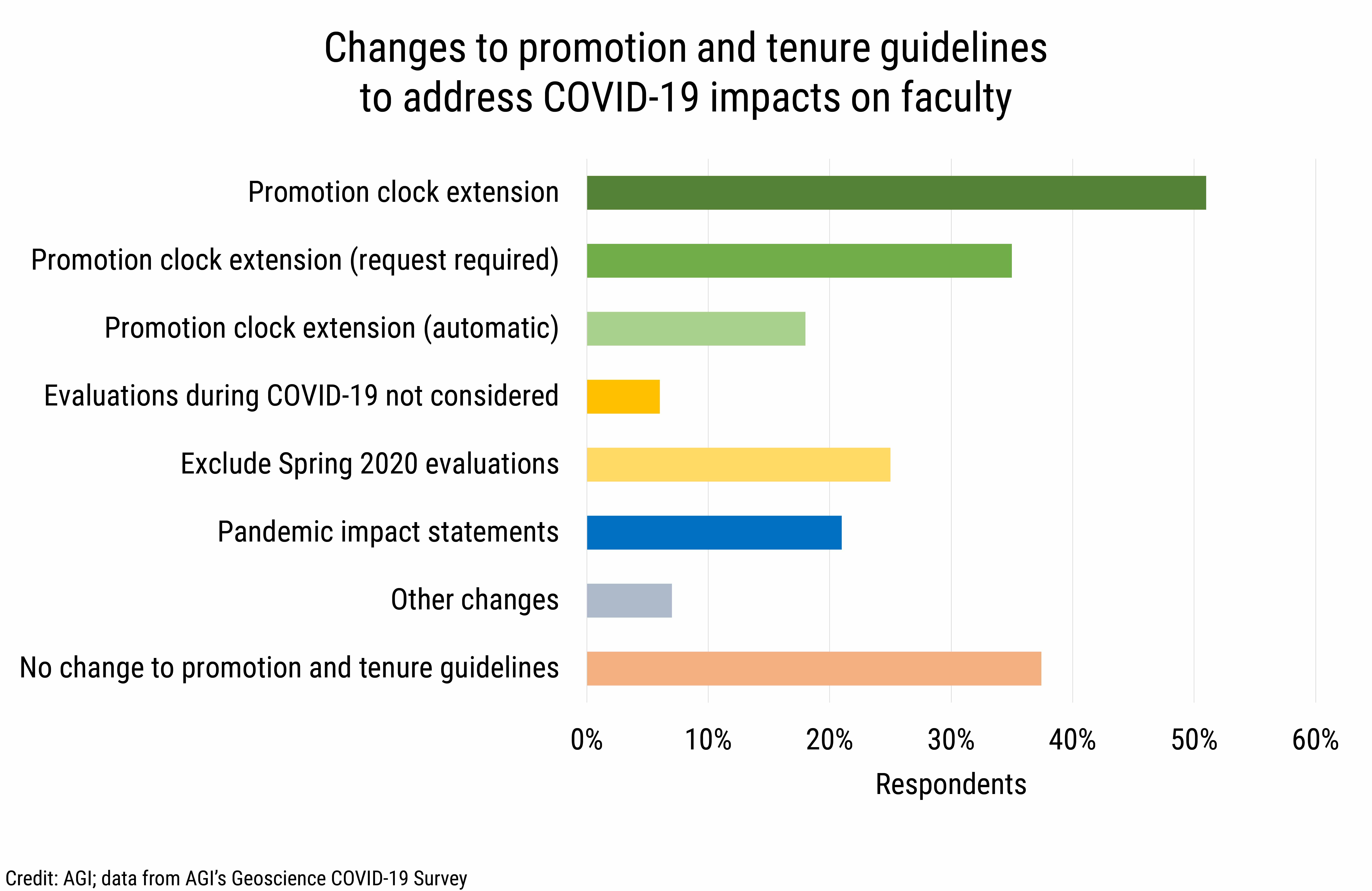
DB_2021-014 chart 08: Changes to promotion and tenure guidelines to address COVID-19 impacts on faculty (Credit: AGI; data from AGI's Geoscience COVID-19 Survey)
AGI
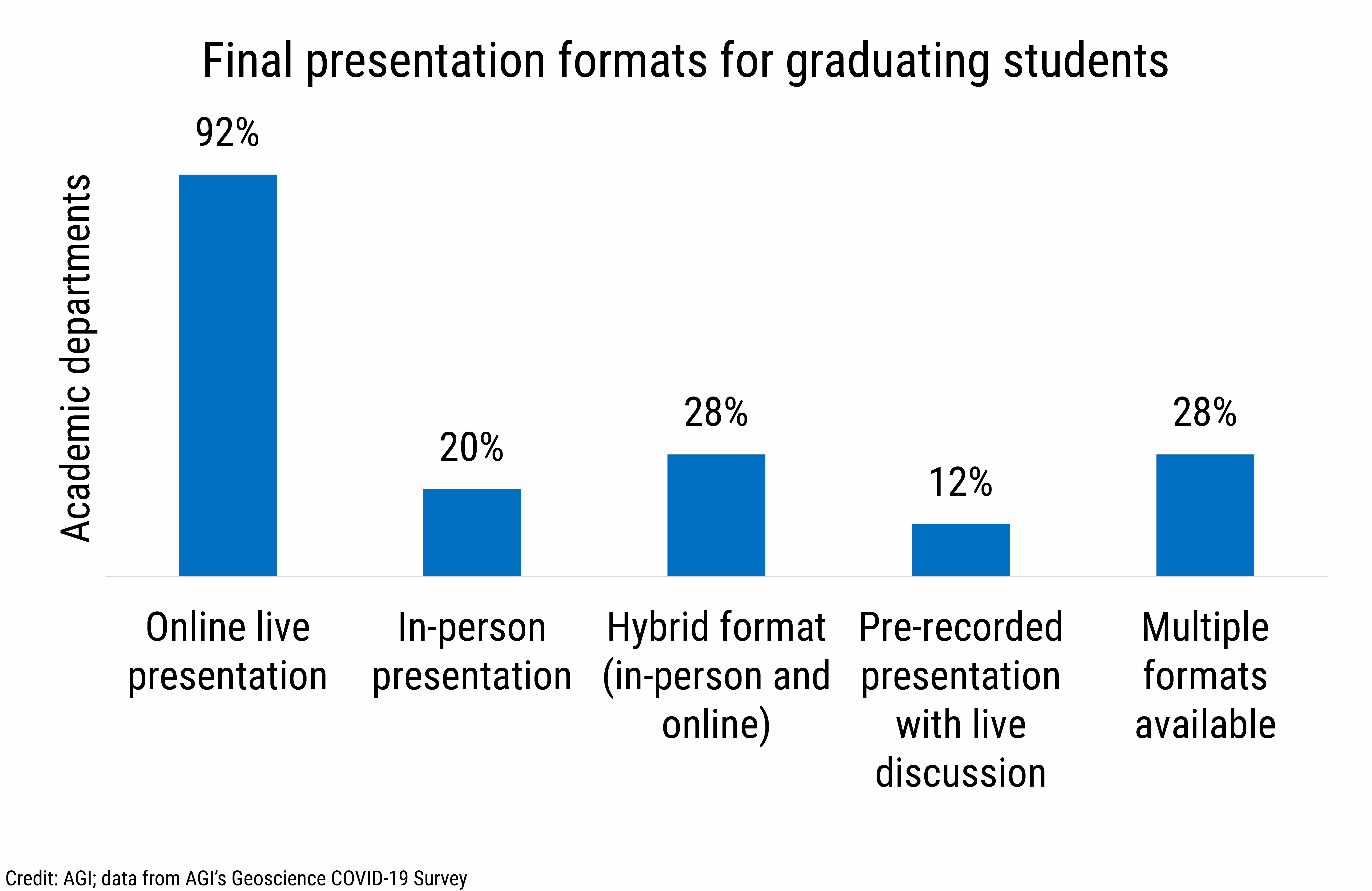
DB_2021-014 chart 09: Final presentation formats for graduating students (Credit: AGI; data from AGI's Geoscience COVID-19 Survey)
AGI
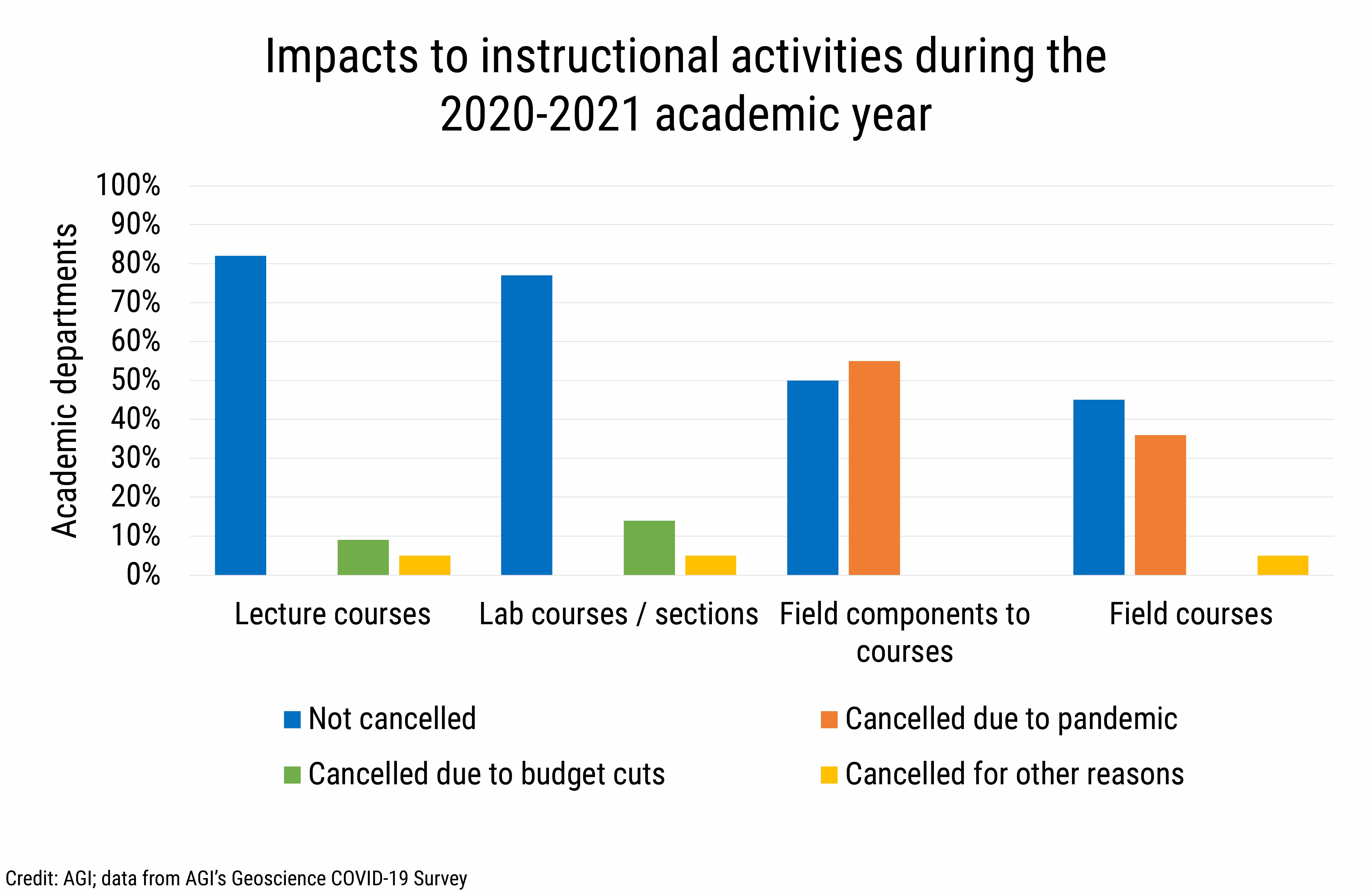
DB_2021-014 chart 10: Impacts to instructional activities during the 2020-2021 academic year (Credit: AGI; data from AGI's Geoscience COVID-19 Survey)
AGI
Enrollments and degrees
Compared to the 2019-2020 academic year, enrollments were lower for just
over half of departments this academic year, and degrees conferred this
academic year were lower for one-quarter of departments. In addition,
15% of departments reported an increase in degrees conferred compared to
the 2019-2020 academic year.
Planning for next term
Since December 2020, institutional planning for the next academic term
has increasingly focused on a return to normal operations, with 52% of
departments reporting in April 2021 expecting to return to normal
operations in the next academic term. In April 2021, there was a sharp
increase in the percentage of departments indicating hybrid formats for
the next academic term, and some of this may be in part from
introduction of this option on the survey. In addition, 40% of
departments reported expecting the use of in-person instruction with
pandemic related restrictions for the next academic term.
While departments are increasingly expecting to return to normal
operations, in April 2021, just over half of departments indicated that
faculty had requested to teach virtual lecture courses and 29% of
departments reported faculty requesting the option to teach virtual labs
for the next academic term.
Concerns
Concerns by departments that were moderately to extremely driven by the
pandemic have declined across most categories, especially since
February 2021. The exceptions are workplace safety, which has been a
concern of at least half of departments since August 2020, and the
ability to maintain staffing levels which has been a concern that has
been reported by an increasing percentage of departments since August
2020.
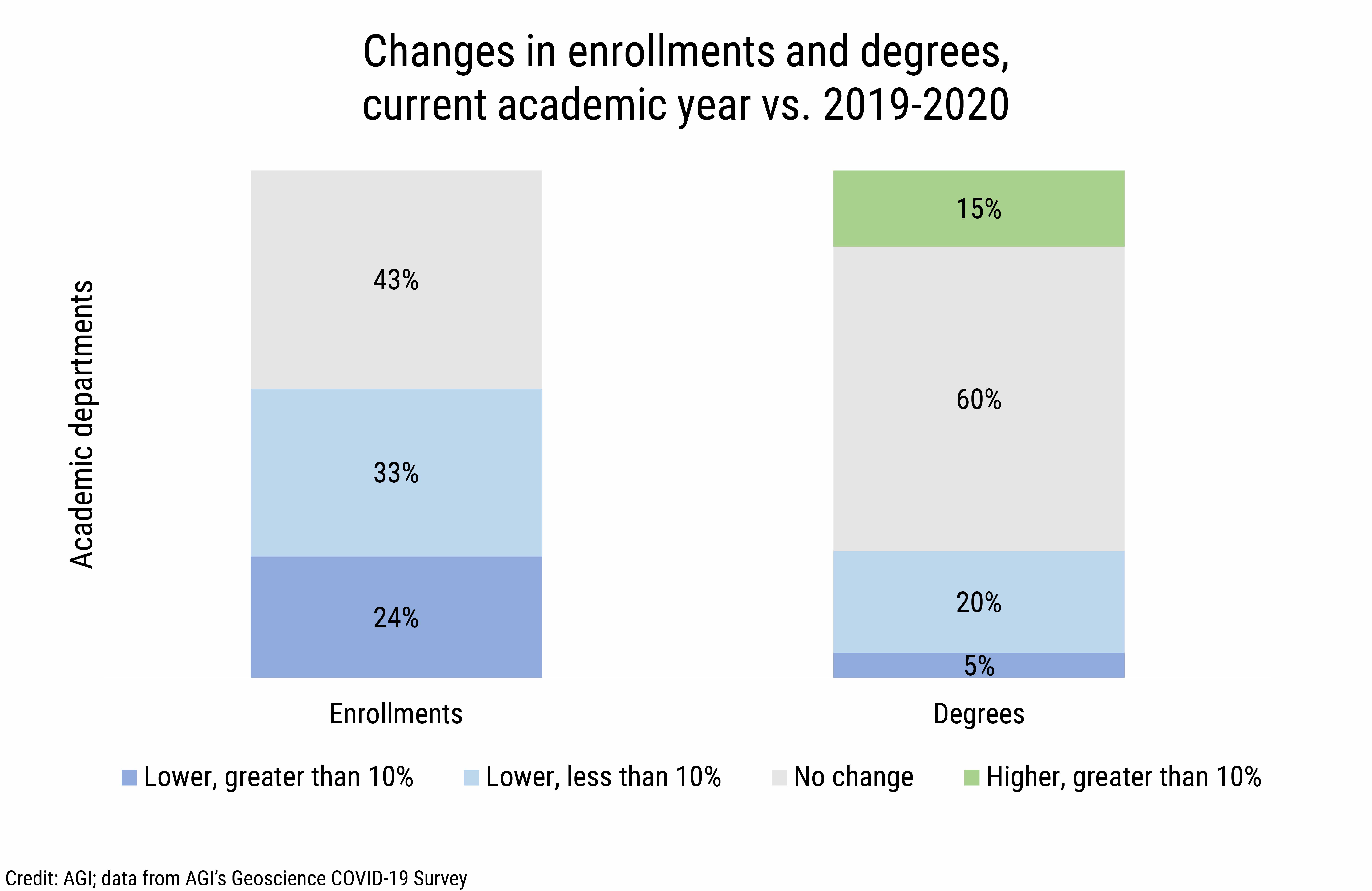
DB_2021-014 chart 11: Changes in enrollments and degrees, current academic year vs. 2019-2020 (Credit: AGI; data from AGI's Geoscience COVID-19 Survey)
AGI
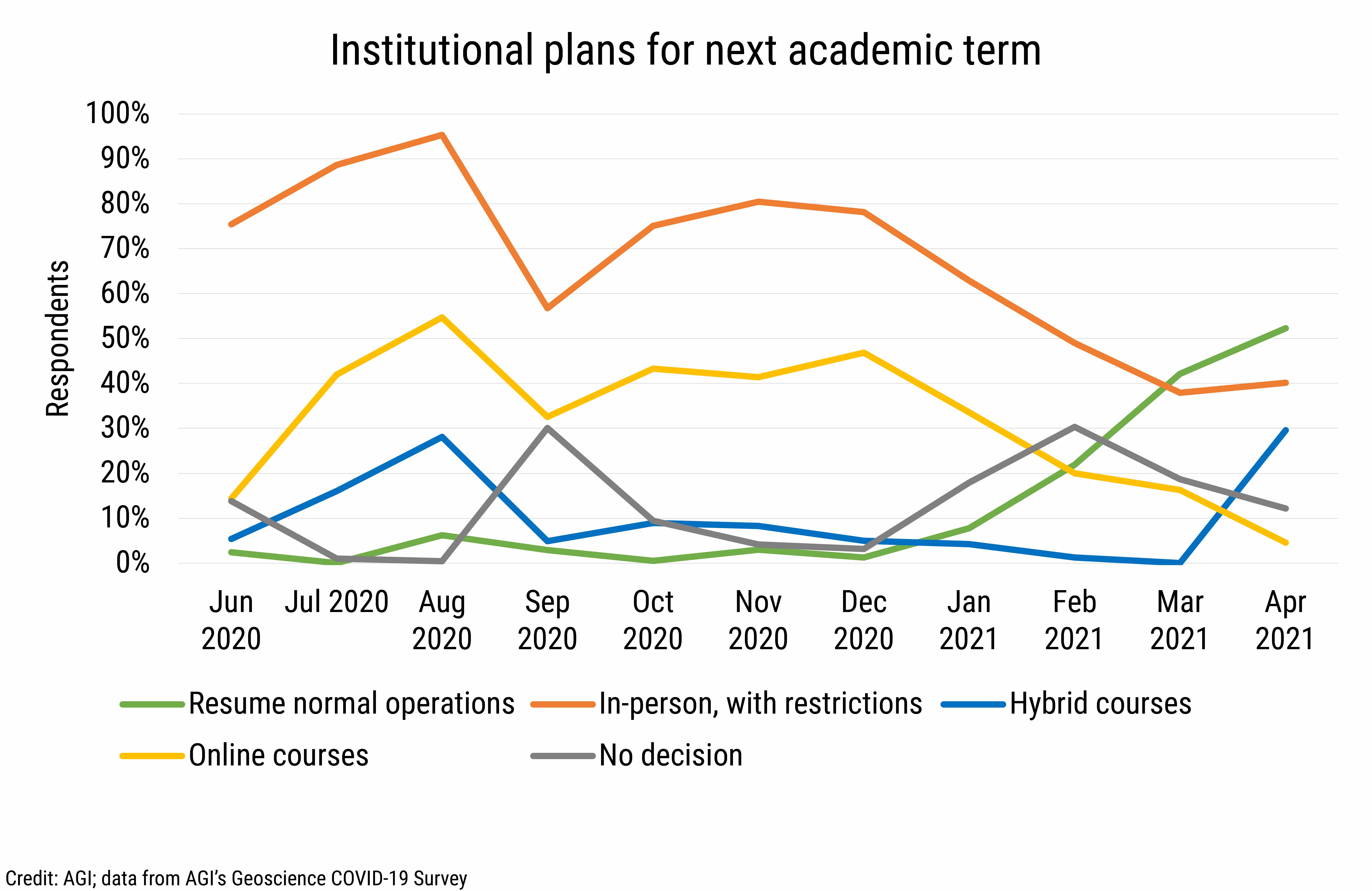
DB_2021-014 chart 12: Institutional plans for next academic term (Credit: AGI; data from AGI's Geoscience COVID-19 Survey)
AGI
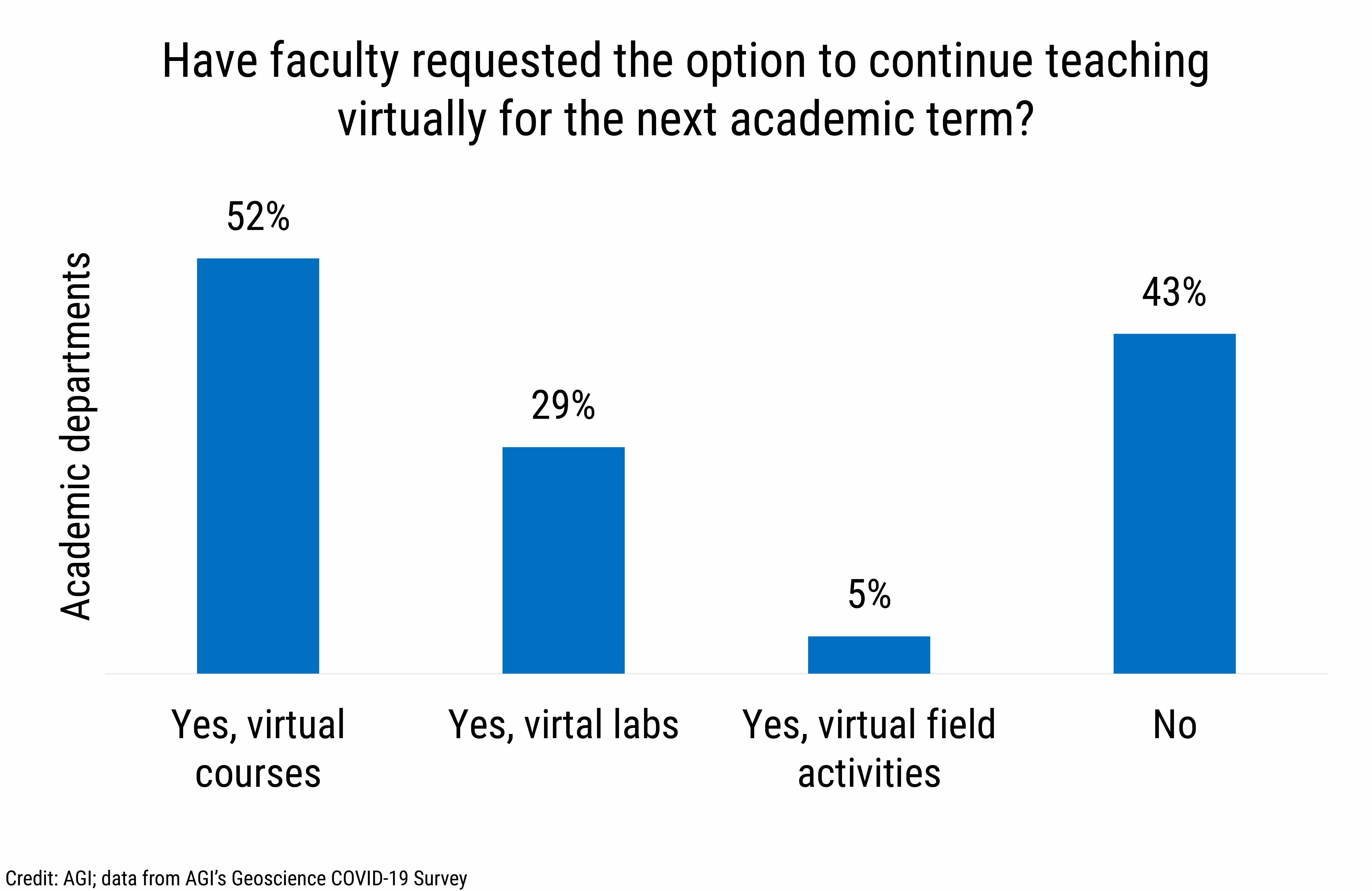
DB_2021-014 chart 13: Have faculty requested the option to continue teaching virtually for the next academic term? (Credit: AGI; data from AGI's Geoscience COVID-19 Survey)
AGI

DB_2021-014 chart 14: Concerns of geoscience departments moderately to extremely driven by COVID-19 (Credit: AGI; data from AGI's Geoscience COVID-19 Survey)
AGI
We will continue to provide current snapshots on the impacts of COVID-19
on the geoscience enterprise throughout the year. For more information,
and to participate in the study, please visit:
www.americangeosciences.org/workforce/covid19
Funding for this project is provided by the National Science Foundation
(Award #2029570). The results and interpretation of the survey are the
views of the American Geosciences Institute and not those of the
National Science Foundation.